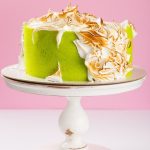One of the most common questions among bakers is whether it’s possible to freeze cakes before decorating. The answer is yes, and it can actually be a game-changer in the world of baking.
Freezing cakes before decorating not only allows for better time management but also enhances the overall texture and moisture of the cake. In this comprehensive guide, we will explore the benefits, proper preparation techniques, debunk common misconceptions, delve into the science behind freezing cakes, provide guidelines for defrosting, and even showcase beautiful masterpieces that were created from frozen cakes.
When it comes to baking intricate cakes for special occasions or large gatherings, timing is everything. Juggling between baking and decorating can be quite overwhelming. However, by freezing your cakes beforehand, you can alleviate some of that stress. Freezing cakes effectively postpones the task of decorating until a more convenient time while ensuring that your cake remains fresh and moist throughout the process.
Not only does freezing cakes offer practicality but it also has numerous benefits when it comes to cake texture and moisture. By freezing the cake before decorating, you are locking in moisture and creating a denser and more structurally sound base that can withstand various fillings and decorations. Moreover, when defrosted properly, frozen cake layers can actually taste even better than freshly baked ones as they have had time for their flavors to meld together.
In the following sections of this article, we will further explore the benefits of freezing cakes before decorating as well as provide step-by-step instructions on proper preparation techniques. We will also debunk common misconceptions about this technique while delving into the science behind why freezing enhances both texture and moisture in cakes.
So if you’ve ever wondered whether freezing your cake layers is a good idea or not, keep reading to unlock the potential of freezing cakes before decorating.
The Benefits of Freezing Cakes Before Decorating
Freezing cakes before decorating can be a game-changer for both amateur home bakers and professional cake decorators. Not only does it allow for better time management, but it also enhances the texture and moisture of the cake. In this comprehensive guide, we will explore the benefits of freezing cakes before decorating and provide step-by-step instructions on how to properly prepare and defrost your frozen cake.
One of the main benefits of freezing cakes before decorating is that it allows you to plan ahead and manage your time more efficiently. Baking a cake can be a time-consuming process, especially if you’re working on multiple orders or have a busy schedule. Freezing your cakes in advance can help alleviate some of the stress by allowing you to bake the cakes at your convenience and decorate them later when you have more time.
Another advantage of freezing cakes before decorating is that it enhances the texture and moisture of the cake. When a cake is frozen, the water content in the batter turns into ice crystals. These ice crystals act as tiny spikes that break apart the gluten structures in the cake, resulting in a finer crumb texture. Additionally, as the ice crystals melt during defrosting, they release moisture back into the cake, making it incredibly moist and tender.
To properly freeze a cake before decorating, follow these step-by-step instructions:
- Allow your freshly baked cake layers to cool completely.
- Wrap each individual layer tightly with plastic wrap to prevent freezer burn.
- Place the wrapped layers in an airtight container or freezer bag for extra protection.
- Label each container with the date and type of cake.
- Place the containers in the freezer and ensure they are stored upright to prevent any damage to decorations or toppings.
By following these steps, you can ensure that your frozen cakes retain their quality during storage and are ready whenever you need them for decoration.
Proper Preparation
Freezing cakes before decorating them can be a great way to save time and make the decorating process smoother. However, it is important to properly prepare your cakes before freezing to ensure that they maintain their freshness and quality. Here are some step-by-step instructions to help you freeze your cakes effectively:
- Allow the cake to cool completely: Before freezing your cake, make sure that it has cooled down completely. This will prevent condensation from forming inside the packaging and affecting the texture of the cake.
- Wrap the cake tightly: Use plastic wrap or aluminum foil to wrap the entire cake tightly. Make sure there are no gaps or openings where air can enter. This will help to prevent freezer burn and maintain the moisture of the cake.
- Place in an airtight container or freezer bag: After wrapping your cake, place it in an airtight container or freezer bag. This provides an extra layer of protection against freezer burn and ensures that the cake stays fresh during freezing.
- Label and date the container: To keep track of your frozen cakes, don’t forget to label and date each container or bag. This will help you identify them later and use them in a timely manner.
- Freeze at 0°F (-18°C) or below: Place your wrapped and labeled cakes in your freezer set at 0°F (-18°C) or below. The lower temperature will help preserve the texture and flavor of the cakes.
Remember, freezing a well-prepared cake can extend its shelf life by several weeks, allowing you to work ahead on decorating projects or simply enjoy delicious homemade treats whenever you desire.
| Step | Description |
|---|---|
| 1. | Allow the cake to cool completely |
| 2. | Wrap the cake tightly |
| 3. | Place in an airtight container or freezer bag |
| 4. | Label and date the container |
| 5. | Freeze at 0°F (-18°C) or below |
Common Misconceptions
Freezing cakes before decorating is a technique that has gained popularity among bakers and pastry chefs. However, there are still some common misconceptions surrounding this practice. In this section, we will debunk these myths and provide clarification on the truth about freezing cakes before decorating.
Myth 1: Freezing ruins the texture of the cake
One of the biggest misconceptions about freezing cakes is that it ruins their texture. Some people believe that freezing causes the cake to become dry or lose its softness. However, when done correctly, freezing can actually help maintain the moisture in the cake and produce a tender texture.
The key is to properly wrap and store the cake to prevent freezer burn and minimize any potential texture changes. By following proper freezing techniques, you can enjoy a deliciously moist and tender cake even after it has been frozen.
Myth 2: Frozen cakes cannot be decorated as beautifully
Another common misconception is that frozen cakes cannot be decorated as beautifully as fresh ones. This myth stems from the belief that freezing alters the appearance of the cake, making it less visually appealing. However, with the right techniques and tools, frozen cakes can be just as stunning as fresh ones.
It’s important to allow the cake to fully thaw before decorating, as frosting or fondant may not adhere well to a cold surface. Once thawed properly, you can decorate your cake with intricate designs, vibrant colors, and delicate details just like you would with a fresh one.
Myth 3: Freezing alters the flavor of the cake
Some people worry that freezing their cakes will alter their flavor or result in a “freezer taste.” This is not true if proper precautions are taken during storage. To prevent any off-flavors, make sure to tightly wrap your cake in plastic wrap or aluminum foil before placing it in an airtight container or freezer bag.
This will help protect it from picking up any odors from the freezer and maintain its original taste. When it comes time to defrost your cake, do so slowly in the refrigerator rather than at room temperature, as this will help preserve the flavor and consistency of the cake.
By debunking these common myths about freezing cakes before decorating, you can feel confident in using this technique to enhance your baking skills. Freezing cakes offers numerous benefits, including improved texture and moisture retention, the convenience of time management, and the ability to create beautiful designs. So go ahead and try freezing your cakes before decorating – you may discover a whole new world of possibilities in your baking endeavors.
The Science behind It
When it comes to freezing cakes before decorating, one might wonder what the science is behind this technique and how it actually enhances the texture and moisture of the cake. Freezing a cake can significantly improve its overall quality, making it easier to work with and resulting in a moist and delicious final product.
One of the main reasons why freezing enhances cake texture is due to the formation of ice crystals. When a cake is frozen, the water molecules inside it freeze and expand, creating tiny ice crystals. These ice crystals act as little spikes that break down the structure of the cake, causing it to become more tender and moist when thawed. This process helps prevent a dry and crumbly texture that can occur during baking.
Additionally, freezing cakes slows down the staling process. Over time, baked goods naturally lose moisture and become stale. However, by freezing a cake before decorating it, you are essentially putting it on hold. The moisture within the cake remains locked in while frozen, preventing it from evaporating and keeping the cake fresher for longer periods.
To better understand how freezing affects cake moisture retention and texture enhancement, consider the following points:
Ice Crystal Formation
- During freezing, water molecules within the cake form ice crystals.
- These ice crystals break down the structure of the cake.
- The result is a more tender and moist texture when thawed.
Slowing Down Staling
- Freezing puts the staling process on hold.
- Moisture within the cake remains intact while frozen.
- This prevents moisture loss during storage and maintains freshness.
Guidelines for Defrosting
Once you have successfully frozen your cake, it is important to know how to defrost it properly to maintain its texture and taste. Improper defrosting can lead to a soggy or dry cake, which can negatively impact the overall presentation. Here are some guidelines for effectively thawing your frozen cake:
- Slow and steady wins the race: The key to defrosting a frozen cake is to do it slowly. Avoid using methods such as microwaving or placing the cake in direct sunlight, as these can cause uneven thawing and result in a compromised texture. Instead, transfer the frozen cake from the freezer to the refrigerator and allow it to thaw slowly overnight or for at least 24 hours.
- Keep it covered: When thawing your cake in the refrigerator, it is important to keep it covered to prevent any unwanted moisture from seeping into the cake. This can be done by placing a plastic wrap or an airtight container over the cake before putting it in the fridge.
- Maintain patience: It can be tempting to rush the defrosting process, especially when you’re excited about decorating your cake. However, patience is key when it comes to thawing a frozen cake. Avoid removing the cake from the refrigerator too early or attempting to speed up the process by increasing room temperature. Allow enough time for the entire cake to thaw evenly before taking it out for decoration.
Follow these guidelines for defrosting your frozen cakes, and you’ll be rewarded with a perfectly thawed and ready-to-decorate canvas that will make your creations shine even brighter.
| Guideline | Description |
|---|---|
| Slow and steady wins the race | Thaw the cake in the refrigerator slowly overnight or for at least 24 hours |
| Keep it covered | Ensure the cake is covered with plastic wrap or an airtight container to prevent moisture absorption |
| Maintain patience | Avoid rushing the defrosting process and allow enough time for the entire cake to thaw evenly before decorating |
Alternative Ingredients
When it comes to freezing cakes before decorating, one of the concerns that arise is whether or not the decorations will survive the freezing process. However, with proper knowledge and techniques, there are a variety of alternative ingredients that can withstand being frozen and still maintain their beauty when it comes time to decorate.
Buttercream Frosting
Buttercream frosting is a popular choice for cake decorations due to its smooth texture and versatility. The good news is that buttercream frosting is actually freezer-friendly. Before freezing your cake, make sure to pipe or spread a thick layer of buttercream frosting onto the cake’s surface.
The fats in the butter help protect the frosting from freezer burn and maintain its texture during thawing. Once the cake is defrosted, you can add additional decorations on top without sacrificing any flavor or aesthetic appeal.
Fondant
Fondant is another commonly used decoration for cakes, known for its smooth and polished appearance. Many people wonder if fondant can survive the freezing process without becoming sticky or losing its shape. The answer is yes. Fondant can be frozen successfully, but there are some precautions to keep in mind.
Firstly, ensure that your fondant decorations are completely dry before placing them on the cake. Moisture trapped within the fondant can cause it to become sticky during thawing. It’s also important to store your fondant-covered cake in an airtight container to prevent condensation from forming on the surface as it thaws.
Chocolate Ganache
For those who prefer a decadent chocolate ganache as their cake decoration, you’ll be pleased to know that this rich topping can endure freezing as well. For best results, allow your ganache to cool completely before applying it to your cake.
Once hardened on your cake, the ganache creates a protective barrier that prevents freezer burn. When the cake is ready to be decorated, you can simply add additional ganache drizzles or even use it as a base for other decorations without compromising its taste or texture.
It’s worth noting that delicate decorations such as fresh fruits or fragile flowers may not survive the freezing process. These types of decorations are best added to your cake after it has been thawed to ensure their freshness and integrity. By exploring alternative ingredients that can withstand freezing, you can have the freedom to prepare and decorate your cakes in advance without sacrificing the beauty or taste of your final creation.
Masterful Decorations
When it comes to decorating cakes, freezing them before adding the final touches can be a game-changer. Freezing cakes prior to decoration offers numerous benefits that can elevate the finished product and make for an easier, stress-free decorating process. In this section, we will delve into some stunning examples of cakes that were frozen before decorating, showing just how beautiful and masterful they can turn out.
One of the main advantages of freezing cakes before decorating is the ability to create intricate designs without worrying about cake crumbs. When a cake is not frozen, it tends to crumble when frosting or applying intricate decorations.
However, by freezing the cake first, the texture becomes firmer and less prone to crumbling. This allows decorators to confidently apply smooth layers of frosting, engage in detailed piping work, and create elaborate designs without any fear of ruining the cake’s structure.
Another reason why freezing cakes before decorating is highly recommended is that it allows for better time management. By freezing the cake layers in advance, bakers can prepare for their decoration process at their convenience.
Whether it’s a last-minute order or a personal project with a tight schedule, having pre-frozen cake layers on hand ensures that you always have a head start. It also means that you can take breaks during the decorating process without worrying about the freshness or stability of your cake.
Let’s take a moment to appreciate some truly stunning cakes that were frozen before decorating. These masterpieces showcase what can be achieved when decorators take advantage of this technique. From elegant wedding cakes with intricate lace patterns to whimsical birthday cakes featuring lifelike fondant characters and vibrant colors – each one is a testament to how freezing cakes can open up endless possibilities for creativity and artistry.
Top Tips from Baking Experts
Professional bakers are no strangers to freezing cakes before decorating, and they have valuable insights to share. These baking experts have mastered the art of freezing cakes and understand how it can enhance the final product. Here are some top tips from professional bakers that will help you achieve delicious and beautifully decorated cakes by utilizing the technique of freezing.
One important tip from professional bakers is to wrap your cake properly before freezing it. This ensures that no air or moisture can get into the cake, which could cause freezer burn and affect the texture.
Bakers recommend using multiple layers of plastic wrap or aluminum foil to tightly wrap the cake, followed by placing it in a freezer-safe bag or container for extra protection. Labeling each cake with its flavor, size, and date frozen is also helpful for organization and easy retrieval.
Another valuable tip is to freeze the cake at its peak freshness. This means allowing the cake to cool completely before wrapping and freezing it. Professional bakers often bake their cakes in advance, let them cool overnight, then wrap and freeze them the next day. Freezing at this point helps lock in moisture and prevents any staleness from developing during storage.
When it comes to defrosting a frozen cake, professional bakers suggest transferring it directly from the freezer to a refrigerator rather than leaving it out at room temperature. Slow thawing in the fridge helps maintain the cake’s moistness as gradual defrosting prevents condensation on the surface that might lead to a soggy texture. It is advised to keep the wrapped cake in the fridge for 24-48 hours before decorating so that it has enough time to fully thaw.
By following these tips from baking experts, you can harness their knowledge and experience to successfully freeze cakes before decorating. Whether you are preparing for a special occasion or simply want your homemade cakes to taste as fresh as possible, freezing cakes beforehand can be a game-changer in achieving moist, flavorful results. Don’t be afraid to experiment and adapt these tips to your own baking style to elevate your cake-making skills.
Conclusion
In conclusion, freezing cakes before decorating is a game-changer for any baker. Not only does it offer numerous benefits, but it also enhances the texture and moisture of the cake. By following proper preparation techniques and guidelines for defrosting, you can effectively freeze and thaw your cakes without compromising their quality.
One of the main benefits of freezing cakes before decorating is the convenience it provides. By preparing and freezing your cakes in advance, you can save time and reduce stress when it comes to decorating them. This is especially useful for special occasions or events where you may have multiple cakes to decorate.
Additionally, freezing cakes before decorating can actually improve their texture and moisture. The freezing process allows the moisture within the cake to remain locked in, resulting in a more moist and flavorful final product. This can be particularly beneficial for dense or dry cakes that tend to benefit from a little extra moisture.
Lastly, by exploring alternative ingredients and decorations that can survive the freezing process, you can unlock even more creative possibilities when it comes to decorating your cakes. From intricate buttercream designs to delicate sugar flowers, there are countless options for creating stunning frozen masterpieces.
Overall, freezing cakes before decorating is a technique that every baker should consider incorporating into their repertoire. Whether you’re looking to save time, improve texture and moisture, or experiment with new decorations, this method has the potential to elevate your cake creations to new heights. So don’t hesitate to embrace the power of freezing and unleash your creativity in the kitchen.
Frequently Asked Questions
Is it OK to freeze cake before decorating?
Freezing a cake before decorating is absolutely okay and can even be beneficial in some cases. Freezing the cake helps to keep it firm, making it easier to handle and reducing the chances of it crumbling or breaking during the decorating process.
Additionally, freezing can actually enhance the flavor and moisture of certain types of cakes, particularly ones that are prone to drying out quickly. However, it is important to note that not all cakes freeze equally well, so it’s advisable to check the specific recipe or consult with experienced bakers before deciding to freeze a particular type of cake.
Is it better to freeze cake before or after frosting?
The optimal time to freeze a cake largely depends on personal preference and convenience. Both methods have their advantages and drawbacks. Freezing the cake before frosting allows for easier handling as well as reducing the risk of damage from applying frosting directly on a fragile cake. It also provides an opportunity to decorate with more intricate designs because there’s no need to worry about smudging or ruining previously applied frosting while working on other parts of the cake.
On the other hand, freezing after frosting offers certain benefits too. The frosting acts as a protective barrier preventing any potential freezer burn or moisture loss during storage. Furthermore, freezing after adding frosting allows flavors to meld together over time, potentially enhancing the taste once thawed.
How do you thaw a frozen cake for decorating?
Thawing a frozen cake properly is crucial in order to preserve its taste and texture when decorating. The safest method for thawing a frozen cake is gradually bringing it back to room temperature in order to prevent any drastic changes that could affect its quality. Start by transferring the frozen cake from the freezer onto a wire rack or plate and place it in the refrigerator for several hours or overnight depending on its size and density.
Once perfectly thawed, remove it from the refrigerator and let it sit at room temperature for an additional hour or two before commencing with decoration. This slow thawing process helps retain moisture within the cake while also keeping any potential condensation or water droplets away that could negatively impact the decorating process.

Welcome to my blog about home and family. This blog is a place where I will share my thoughts, ideas, and experiences related to these important topics. I am a stay-at-home mom with two young children. I hope you enjoy reading it! and may find some helpful tips and ideas that will make your home and family life even better!





